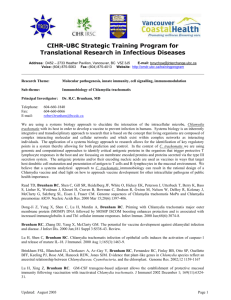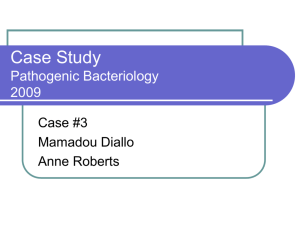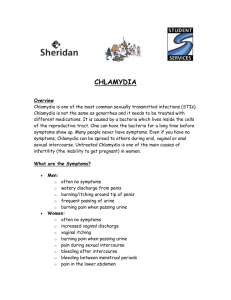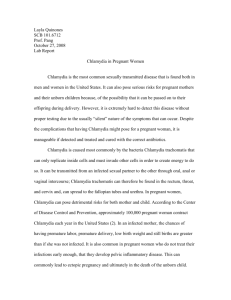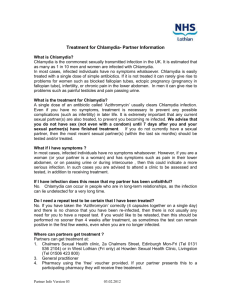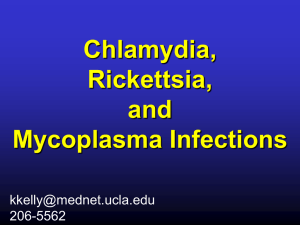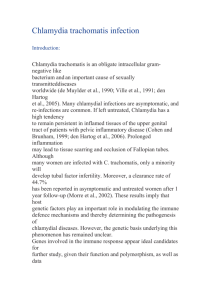julia
advertisement
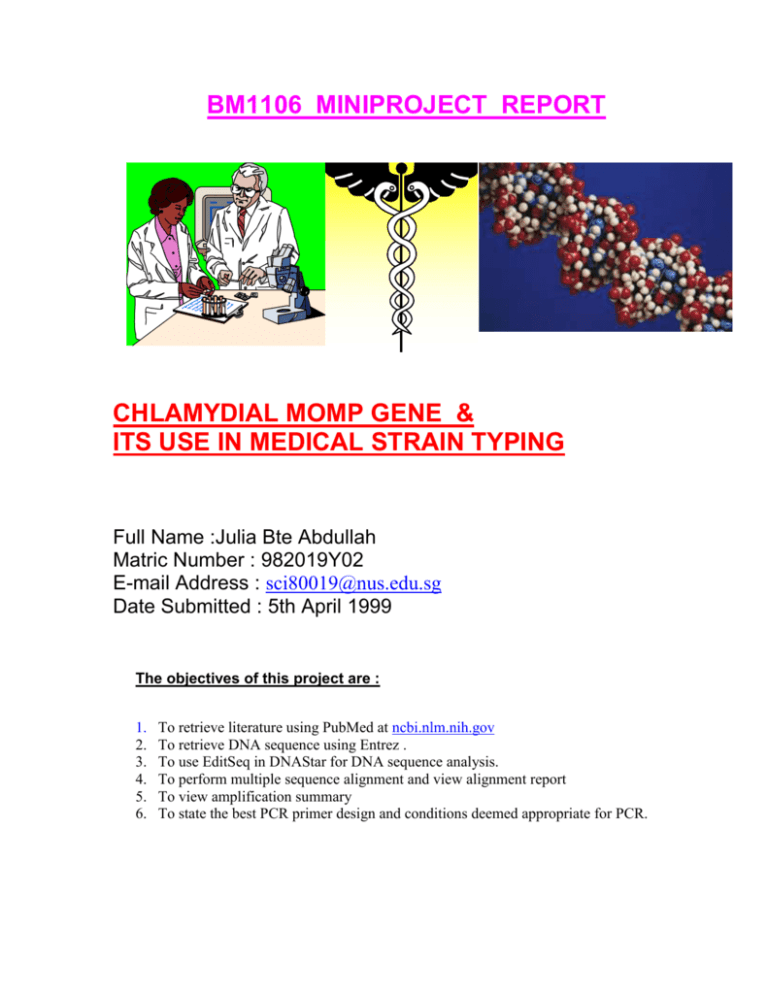
BM1106 MINIPROJECT REPORT CHLAMYDIAL MOMP GENE & ITS USE IN MEDICAL STRAIN TYPING Full Name :Julia Bte Abdullah Matric Number : 982019Y02 E-mail Address : sci80019@nus.edu.sg Date Submitted : 5th April 1999 The objectives of this project are : 1. 2. 3. 4. 5. 6. To retrieve literature using PubMed at ncbi.nlm.nih.gov To retrieve DNA sequence using Entrez . To use EditSeq in DNAStar for DNA sequence analysis. To perform multiple sequence alignment and view alignment report To view amplification summary To state the best PCR primer design and conditions deemed appropriate for PCR. INTRODUCTION: 1.BIOLOGICAL & MEDICAL SIGNIFICANCE OF CHLAMYDIA SPECIES Chlamydia is a sexually-transmitted disease (STD) caused by bacterial infection. It is popularly known as “ the silent epidermic” because three-quarters of the women and half of the men who contracted the disease have no symptoms initially until complications arise later. Although Chlamydia can produce serious consequences, it's not as well known as other STDs, such as gonorrhea or syphilis. It is a gram negative obligate intracellular bacteria that cause acute and chronic disease in mammalian and avian species. Chlamydia - General Characteristics Obligate intracellular parasite Gram-negative bacteria "Energy parasites" - can't synthesize own ATP Virulence factors : Intracellular growth Inhibition of phagolysosome fusion Endotoxin Chlamydia - Multiplication Elementary bodies: small dense cells; rigid cell walls; ~0.3um in diameter; extracellular form - attaches to and enters host cell Reticulate bodies: ~8 hours later within host cell; ~1um in diameter, divide by binary fission for 24-48 hours within phagosome --> differentiate into elementary bodies --> host cell lysis releases elementary bodies . The genus Chlamydia is comprised of four species: C. trachomatis, C. pneumoniae, C. precorum and C. psittaci (1- 4). For this project, we will be dealing with mainly Chlamydia Trachomatis. C. trachomatis is divided into 15 serovars (5-8). Serovars A, B, Ba and C are agents of trachoma (9), leading cause of preventable blindness, endemic in the third worlds. Serovars L1-L3 are the agents of lymphogranuloma venereum. Serovars D-K are a common cause of sexually transmitted genital infection worldwide: cervitis, endometritis/salpingitis(10) in females and uretrities(11) in both males and females. Endometritis/salpingitis can lead to agglutination of salpinx with a higher risk of extrauterine pregnancy and infertility. Genital infection can cause acute infection and persistent infection occasionally without any clinical signs. Generally, these infections are treatable once they are diagnosed, however, without any treatment the infections can progress to severe chronic inflamantation leading to infertility, ectopic pregnancy, induced abortion or child delivery. Moreover, infants to infected mothers can be infected during birth leading to conjunctivitis or pneumonia (12-14). The serology of C.trachomatis is more interesting in cases of chronic infections than in acute infections. C. pneuomoniae is an important respiratory pathogen in human and cause up to 10% of community-acquired pneumonia cases. It has been associated with acute respiratory diseases, pneumonia, asthma, bronchitis, pharyngitis, acute chest syndrome of sickle cell disease, coronary heart disease and Guillain-Barre syndrome (15-17). C. psittaci infects a diverse range of host species from molluscs through birds to mammals and also causes severe pneumonia. In animals, C. psittaci and C. pecorum are capable of inducing diverse disease syndroms like pneumonia, enteritis, polyserositis, encephalitis and conjunctivitis. Serological testing, now an established approach in many countries, has been shown to provide a comprehensive answer for the detection of C. trachomatis infection. In suspected deep-seated infections, serum sampling reduces the necessity for invasive procedures which are required for antigen direct detection. In cases of lower urogenital infections, collection limitations such as effectiveness of scrape sampling procedure, specimen handling and transportation difficulties have to be weighed. Above all, there remains the issue that most Chlamydial infections are asymptomatic. Therefore, an infection may persist for a long time, ascend the upper genital tract causing deep and chronic infections , and increase the probability of false negative results in direct antigen detection. 2. CHLAMYDIAL MAJOR OUTER MEMBRANE PROTEIN (MOMP) AND ITS GENE In the search for a vaccine against Chlamydia infection (Chlamydia Trachomatis specifically), scientists have found out that they can make use of the major outer membrane protein ( MOMP ) of chlamydia and its gene. In fact there is a Chlamydia Trachomatis Genome Project The goal of the Chlamydia Genome Project is to determine the DNA sequence of the chromosome of Chlamydia trachomatis, serovar D (D/UW-3/Cx), trachoma biovar, and L2/434/Bu, LGV biovar. The project is a collaborative effort involving scientists at the University of California at Berkeley and Stanford University . A safe and effective vaccine may require the use of a recombinant polypeptide The MOMP gene may be the source of such a vaccine. Research has demonstrated that unique serological determinants are associated with the MOMP protein and the identification of the genetic sequence for the C.trachomatis MOMP gene provided the basis on which production and optimization of a MOMP- based vaccine has centered. The MOMP gene sequence may also be suitable for the derivation of nucleic acid probes useful in the specific detection of C. trachomatis and its related species. Therefore a primary vaccine can be constructed to combat Chlamydial infections.Various genes are located on the outer membrane protein, all of which are classified and numerically for to its own particular strain. 3. MOLECULAR TYPING OF THE MOMP GENE USING RFLP AND ITS USEFULNESS Restriction Fragment Length Polymorphism (RFLP) is the technique whereby the cleavage of DNA and DNA fragments analysis is used to differentiate organism. Also known as DNA fingerprints, RFLP involved cutting DNA with restriction enzymes and separation according to its size with gel electrophoresis. Restriction enzymes recognise a specific sequence of bases and cut the DNA strand only at those places that have that sequence.It is then blot onto nylon sheet and radioactive DNA probe is added for the interpretationof the bands. Each individual banding pattern is unique and can be used todifferentiate strains from one another. RFLPs have been sequenced to determine what sequence variation is causing the polymorphism. One of the advantages of working with RFLPs is that the sequence need not be known; all that is needed is a genomic clone that can be used to detect the polymorphism. The RFLPdetection and collection of genetic data can be very rapid with this method.However, without sequence information, the interpretation of complicated RFLP allele systems can be very difficult. In the lab, we have seen many different types of RFLP polymorphisms. Interpretation of the type of the polymorphism is based on our knowledge of DNA sequence variation and how chromosomes have evolved and not on any certainty of the cause of the specific polymorphism. Methods Firstly, retrieval of DNA sequences were from the Nucleotide databases in ENTREZ at PubMed at ncbi.nlm.nih.gov. 10 DNA sequences of “Chlamydia Trachomatis and MOMP and complete codons” were chosen . REFERENCE NUMBER STRAIN AF063204 K/UW31/CX AF063203 Ja/IU-A795 AF063202 J/UW36/CX AF063201 Ia/IU-4168 AF063200 I/UW57/CX AF063199 G/UW57/CX AF063198 E/IU-51538 AF063197 D/IU-83786 AF063196 D/IU-72403 AF063194 Ba/Apache-2 DNASTAR was installed. EDITSEQ in DNASTAR was opened and each DNA sequence was opened, copied and pasted from ENTREZ to EDITSEQ. Each sequence was saved as a separate file in EDITSEQ. Next, MEGALIGN in DNASTAR was opened. The sequences which were saved in EDITSEQ was entered. Alignment by Clustal method was done. The phylogenetic tree is as follows: From the above diagram, we can see that strains Ia, I, Ja, J and K are related to one another just as strains Ba, D, E and G are. This is further proven when the sequence distances were viewed. The percentage of similarities are very close for strains Ia, I, Ja, J and K and strains Ba, D, E and G. Below is the sequence distances of the 10 strains used obtained from the View Sequence Distances. Next, a region of multiple sequence alignment to show the conserved regions was produced. The highlighted blue region represents the conserved sequences which were present in most of the strains and the unshaded white region was the region with variable sequences of Chlamydia Trachomatis. At the PRIMERSELECT, we view the locations of the primer pairs of the 10 selected strains. There are 7 primary pairs, 55 located and 15 alternates. In silico amplification was done next. This is by viewing amplification summary. It shows the conditions for the PCR to be carried out. From this table, the primer location was divided into upper and lower regions and the temperature for each is clearly distinguished. It describes in detail the conditions for each primer as well such as primer locations. Last but not least, MAPDRAW was done to show where the restriction enzymes had cut. There are 8 sites cut by the enzymes Alu1 and Ear 1. This process is also known as in silico restriction mapping. In silico restriction mapping was performed to analyse for the possible enzymes-cut-sites to produce DNA fragments. In conclusion, from this project we have shown that it is possible to make use of stored data in PubMed and DNASTAR package and utilized it in such a way that it is possible to predict the outcome of our ‘Chlamydia Genome Project’ to produce a vaccine hopefully in the near future! Also, using sophisticated computational software means we may even omit in vitro or in vivo experimentation. Even though it is still far too early to do so, nevertheless it is possible. REFERENCES 1. http://www.ncbi.nlm.nlh.gov/ 2. http://sequence-www.stanford.edu/group/chlamydia/index.html 3. http://chlamydia-www.berkeley.edu.4231/descript.html 4. http://www.niaid.nih.gov/default.htm
